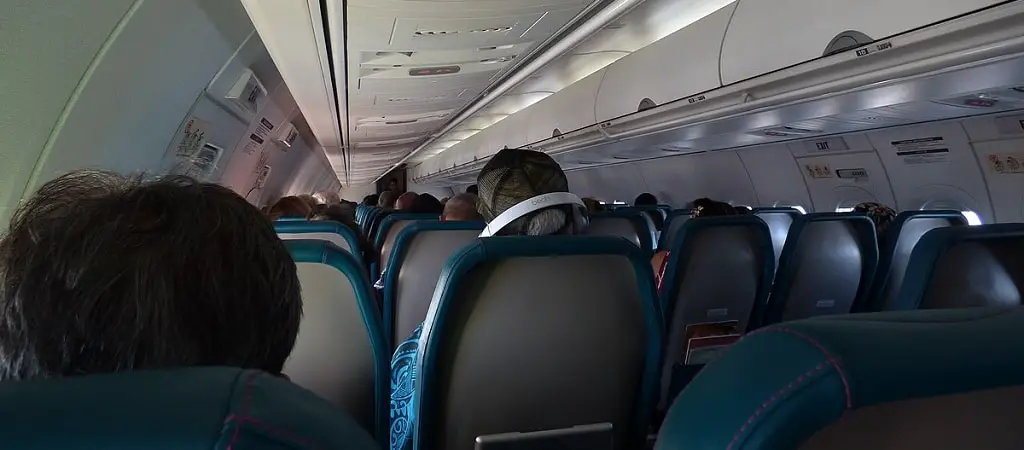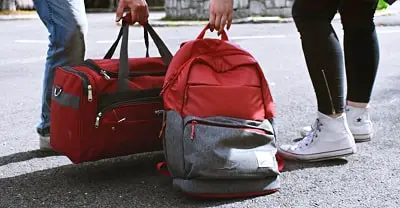For most people, camping is a straightforward activity. You pack your luggage, secure it in a car, a bus or even a train, and travel to your destination. But what if you have to fly? What if your trip is in another country or even another continent? What do you do with your camping and hiking gear? You can’t leave it at home, obviously. Allow me to share a few tips with you on how to take a camping gear on a plane.

Here are the steps on how to take a camping gear on a plane:
- Check the airline’s weight permissions and ensure you are within the limit.
- Decide if you are taking a handbag carry or a checked-in suitcase.
- Check for gear rental possibilities at your camping area or in a nearby town.
- Prioritize light clothing and even wear most of it during the flight.
- Buy most of the food at your destination.
- Follow the rules of what equipment you are allowed to carry or to check-in.
1. Weight Permissions
You need to pack light. Forget all the luxurious amenities that you only want but don’t actually need; merely buy backpacking gear. There is an entire market of camping tools and items designed specifically for backpacking purposes.
As a result, they are ultra-light, perfect for carrying through an airport, and taking onto a plane. Forget about ordinary sleeping bags and mattresses. Make sure that all your gear is portable.
This isn’t just an issue of convenience; airplanes do have weight limits with regards to the luggage you can bring. So, make sure you pack in a manner that allows you to stay within the weight limit. To make it more convenient, I’ve listed you here 37 airlines restrictions and weight limits.
| Airline | Carry-on baggage limits | Hold baggage limits |
| Aer Lingus | 55x40x24cm, 10kg | 1 free 23kg bag 158cm cubed, zero free allowance within Europe |
| Air Canada | 55x40x23cm (9×15.5×21.5in), 10kg (22lb), plus personal item that goes to an maximum size of 16x33x43cm (6x13x17in) | 1x23kg transatlantic, others vary depending on route. |
| Air France | 55x35x25cm, 12kg, plus 1 handbag/laptop | 20kg but varies on some routes |
| Air New Zealand | 115cm total, 7kg + thin laptop pouch | 1x23kg or 2x23kg according to route |
| Alaska Airlines | 61x43x25cm, 5kg | 22.6kg -Baggage fees apply |
| Alitalia | 55x35x25cm, 5kg | 20kg or 2x23kg according to route |
| American Airlines | 56x36x23cm (22x14x9in) plus a Personal Item | |
| Aurigny Air Services | 43x30x18cm, 10kg (6kg some routes) | 20kg |
| British Airways | 56x45x25cm | 90x75x43cm, 23kg x 1 UK domestic/short-haul, 23kg x 2 long-haul |
| Delta Air Lines | 56x45x25cm | 22.6kg – baggage fees apply |
| Easyjet | 56x45x25cm | 20kg total for up to 8 bags |
| Emirates | 55x38x20cm, 7kg | 30kg in Economy, but check with codeshares |
| Finnair | 56x45x25cm, 8kg | 20kg, or 2x32kg to USA & Canada |
| Flybe | 55x40x23cm, 10kg | 20kg |
| Garuda Indonesia | 56x36x23cm, 7kg plus laptop or beauty case | domestic: 20kg for economy / 30kg for business. international: 30kg for both economy and business. |
| Iberia | 55x40x20cm, 10kg | 23kg, or 2x23kg for Americas, Africa & Middle East |
| Icelandair | 55x40x20cm | 20kg |
| Iceland Express | 55x35x25cm plus a laptop and duty free carrier bag, 10kg | 20kg |
| Jet2 | 55x35x25cm, 12kg | 0 |
| KLM | 55x40x20cm or foldable garment bag, 8kg | 20kg or 2x32kg on some routes |
| Lufthansa | 55x40x20cm or foldable garment bag, 8kg | 20kg (more on long haul) |
| Manx2 | 55x35x20cm, 10kg | 0 |
| MIAT Mongolian Airlines | 55x40x20cm, 5kg | 0 |
| Monarch | 56x45x25cm, 10kg | 0 |
| Norwegian | 55x40x23cm, 10kg | 2x20kg |
| Qantas | 115cm (56x36x23cm), 7kg + laptop | 30kg with exceptions between Singapore-Narita, Singapore-Haneda and Singapore-Helsinki |
| Qatar | 50x37x25, 7kg | 30kg or 2x23kg transatlantic |
| Ryanair | 55x40x20cm, 10kg | 0 |
| SAS Scandinavian Airlines | dimensions vary, 7kg | 23 |
| Singapore Airlines | 115cm total, 8kg | 30kg or 2x23kg according to route |
| South African Airways | 115cm total, 8kg | 20kg |
| TAM Airline | 115cm total, 5kg | 2 items, each max 32kg and 158cm max dimensions(International flight) |
| Thomas Cook Airlines | 55x40x20cm, 10kg | |
| Thomson Airways | 55x40x20cm, 10kg | 0 |
| United Airlines | 56x35x23cm (22x14x9in) Plus a Personal bag | 22.6kg -Baggage fees apply |
| Virgin Atlantic Airways | 56x36x23cm, 6kg | 2 items, each max 23kg and 158cm max dimensions |
| IATA recommendation | 56x45x18cm | 158cm max dimension (height+width+length), 32kg per item |
The Proper Weight For Hiking
It is also essential that you pack light if you are planning long hikes. On that matter, I’ve written an in-depth article that discusses the never-ending question; how much should your hiking backpack weigh.
I gathered there 50 examples of the most necessary equipment and calculated the average requirements for the ideal pack. I’ve spent three days pouring through the data – I genuinely suggest that you take a look at this.
2. Backpacks vs. Suitcases
This actually bleeds back into the issue of weight.
You need to determine whether you will carry your things in a suitcase or a pack. If you have no particular preference, then you are encouraged to go with the backpack.
Backpacks are lighter, and you are more likely to take them with you when boarding your flight. A suitcase, on the other hand, will most likely go to the checked baggage area.
If you care about your equipment, if your camping gear is delicate and expensive and you need to watch over it personally, you have to store it in your backpack. Of course, as mentioned above, you need to watch the weight. Pack very carefully.
From my experience, the best solution for that dilemma would be bringing a carry-on backpack. These usually feature the right dimension to fit in the plane’s cabin and offer you some high-quality characteristics for camping.
If you are interested, I’ve written an in-depth article on how to choose a carry-on hiking backpack and added a few of the most recommended packs the market has to offer.

3. Renting vs. Owning
You don’t have to bring your camping gear with you when flying; merely wait until you reach your destination after which you can rent the equipment you need. That would probably be the most convenient approach available.
It allows you to fly without the inconvenience of an armful of luggage. By waiting until your flight lands to rent your gear, you will avoid a lot of unnecessary complications.
Unfortunately, I’ve learned that trick quite late on my journeys. Mostly, I used to buy all the necessary gear upfront and was barely able to manage the weight.
In fact, I’ve discussed a few more issues on a different article, regarding 15 mistakes that I did on my first hike. If you are new to the field of camping – I highly suggest that you take a look at this and avoid the terrible, wrongs steps that I’ve made.
4. Clothing Essentials
As with the rest of your camping gear, you need to prioritize light clothing. Of course, in some cases, the weather conditions of your destination might force you to pack several heavy blankets, socks, jackets, and the like.
But if you have a choice, stick to light clothing. Better yet, wear it. You can get away with adding a few layers to your body. If it feels how during the flight – merely take a few layers off and leave them on the sit. You’ve still removed weight from the backpack.
5. Food Planning
You can take all the food you like when you board your flight. You don’t have to.
You can just as quickly choose to buy your food at your destination. But if you want to carry your food with you, stick with frozen and dried meals, especially the kind that only requires hot water to prepare.

This approach will help you minimize the weight of your backpack. On a side note, even if you can buy water at your destination, you are still encouraged to carry empty water bottles.
Take some water filters as well. Regardless, most airlines wouldn’t permit that you bring liquids to the flight. You would probably be able to carry these on the luggage you check-in, although if you are taking all the gear in the hand luggage – please avoid liquids.

Later on, I will elaborate on a few more restrictions airlines usually agree on so that you won’t bring forbidden equipment to the flight.
6. Know The Rules
There are items that you won’t be permitted to bring with you when you board your flight. Most airports will provide you with an extensive list if you ask. So get acquainted with the rules ahead of time.
Figure out which camping items you will be allowed to take on board and which tools are most likely to get confiscated. This will save you a lot of time.
What Camping Gear Will They Let You Take?
There are slight variations in the way some airlines operate. So camping gear that might be permitted by one airline could be rejected in another; however, there are a lot of items upon which most airlines agree.
For instance, no one will prevent you from bringing your backpack on the plane. You could choose to check the pack if that option is more convenient. But you won’t encounter any resistance if you decide to carry it with you when you board the plane.
Pickaxes & Hiking Poles
Strangely enough, the same rule applies to pickaxes and hiking poles. Of course, you have to pack them in checked baggage. You can’t keep them in your backpack when you board, but you can still bring them.
Animal Repellents
Things get a little complicated when it comes to animal repellents, insect repellents, and insecticides. Repellents with small amounts of CS and CN can be stored in checked luggage if their volume is low.
Some airlines will also permit you to carry insect repellants. But insecticides are strictly prohibited. They won’t even let you bring them in checked baggage.
Camping Stoves
Things are more straightforward with stoves. Airlines won’t stop you from boarding with them so long as they have no fuel. Propane tanks must stay away. You can’t even transport them via checked baggage.
But that is just if they have gas. Empty tanks are fine. But as with repellents and insecticides, you can always buy propane at your destination. Even if you were permitted to carry full containers, they would weigh you down.
If you are not sure how to deal with these products, I highly suggest that you read my article on how to use a propane camping stove. Besides the necessary assembly steps, I’ve also discussed there what you should do if you run out of propane (which, on prolonged adventures, you probably would).
Weapons & Tools
Most other items are more apparent. You can bring flare guns in checked baggage so long as you declare them. Flares are not allowed. No one cares about dry ice, but spear guns and bows and arrows are an issue.
Though, you can also transport those in checked luggage. Lighters and matches are also okay, no matter how you choose to carry them.
Hatchets and any other bladed tools must go in the checked luggage. The same goes for guns and ammo and some batteries. Beverages go in checked baggage.
What if I’m Not Sure About Camping Gear Permissions?
If you have any doubts about the camping gear you wish to bring with you on your flight, do not hesitate to call your airline. The rules keep changing. You don’t want to get caught at a checkpoint with items that you must dispose of because security won’t let you through.
Try to make things easy for everyone at the airport. If you have items that security is likely to frown upon, put them near the top. Don’t force the officers to dig all the way to the bottom of your backpack in search of whatever strange shapes they saw on their screens.
If you think your stove might raise alarms, keep it close. Make sure everyone can see that you have nothing to hide. Otherwise, security will end up ripping your bag open in their attempts to satiate their curiosity.
Forget all the habits you typically practice whenever you have to drive to your camping destination. Road transport is straightforward. You can basically take whatever you want. In fact, you can take as much luggage as your heart desires. Weight isn’t an issue
But airlines are so restrictive. They have to consider so many risks, threats, and hazards. So if you don’t know what to expect, they could turn your whole trip into a nightmare.
How Can You Protect Your Camping Gear on a Plane?
You are encouraged to use a backpack that you can carry with you when you board your flight because you are better placed to protect your camping gear.
But what do you do if you have so much equipment that it has to go in the checked luggage area? Anything can happen once your gear leaves your hands. Your bag could rip open. Your tools could fall out during transportation.
So you need to prepare adequately beforehand.
First of all, pack carefully and make sure your bag is zipped tightly. Secondly, secure the straps. Tie the shoulder straps together to provide a handle for the baggage people to use.
Tighten the adjustment straps and buckle the waist straps backward. The goal is to make sure that no straps are hanging loosely. Otherwise, they could tear off.
Thirdly, where possible, store your backpack in a large duffel bag. That away, the duffel bag can take all the damage while also capturing any camping gear that slips out.
Can you Bring Your Tent with You on Your Flight?
This varies. Some airlines have no problems with tents. You can even carry them in your backpack when you board. Others will ask you to store them in the checked luggage.
A few might prohibit them, but such airlines are very rare. Of course, even the most inviting airlines won’t permit you to carry the tent stakes with you when you board. Those must go in the checked luggage.
But for the most part, you have nothing to fear where tents are concerned. Sleeping bags are bulky, so you don’t need to carry them as well. But no one will stop you.
Conclusions
Carrying your entire camping gear on a plane might seem impossible at first. Nevertheless, if you follow the right steps, things should be okay. I suggest that you pack your stuff within a backpack instead of a suitcase.
This way, you wouldn’t have to check it in, and you will save yourself a lot of time and frustration. Make sure that you follow the weight and dimensions limit of your airline so that you won’t be rejected or forced to pay any fees.
I hope my article was helpful and gave you a better understanding of the topic. If you have any questions, let me know all about them by leaving a comment below!

